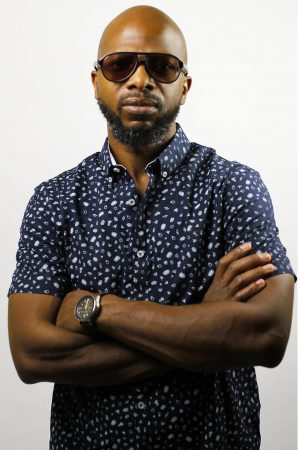
Artwork and photos provided by Michael Johnson
José Romero
editor-in-chief
collegian.editor@tccd.edu
Not only does Michael Johnson pick up the phone to help faculty with technical support issues they may have, but he also picks up a paintbrush to create intricate pieces of art on canvas.
Johnson is TCC’s campus support services coordinator and an artist whose pieces have been featured in galleries from Dallas to Europe. He grew up in Lake Jackson, a small city outside of Houston, and during high school, was primarily focused on sports. It wasn’t until his junior year that he stopped playing basketball and decided to delve deeper into art. After graduating, he went to Prairie View A&M University but hadn’t chosen a major during his first year. After some contention and after being convinced by someone else, he landed on art.
He was hesitant at first because he was unsure he could make money doing it, but his passion surpassed his concerns.
“By the time I left Prairie View, I had done some commissions for the campus,” Johnson said. “I had done some sports pieces for them, and they paid me. It was kind of like a little mini scholarship.”
After his time in Prairie View, he went to the University of Houston for two years. During his time there, he concluded that he was tired of creating art and being in school, so he left both to focus on working white-collar jobs instead.
During his time away from art, however, he had a lingering itch that wouldn’t go away. After 15 years of ignoring it, he gave in.
“I started by doing some black and white pieces, some pen and ink drawings, for a style I called ‘Faceblackness’ style,” Johnson said. “The first series that I did was basically referencing racial topics, things of that nature. The whole style was basically a caricature on Blackface imagery, minstrel show imagery, something that was kind of really sensitive topics.”
His intention with that series was to help the viewer identify with the struggles of the character portraits by showing their vulnerabilities through facial expressions and posture.
“When I created the ‘Faceblackness’ style, series, it really started with me creating one piece that I just felt like it was going to be something that had social commentary, and then from there, I began building more and more characters,” Johnson explained in a YouTube video titled “Flipping The Script.” “It essentially created a storyline that almost like created a community.”
After doing this series, he started to hone in on the style he wanted to emulate. He also switched from painting with an airbrush to using a paintbrush.
“The style I’m doing now is basically pop-culture references of different moments in Black history,” he said.
He wanted to do something that was “dope” with a mix of hip-hop. He looked to artists such as Roy Lichtenstein, Andy Warhol, Jean-Michel Basquiat and Virgil Abloh to perfect his style.
During Johnson’s time away from the art world, he noticed a shift in the culture.
“Internet brought a lot of things together,” he said. “It made a lot of things more international. You started seeing movements in Paris, you started seeing movements in London, different places. The culture started to expand out.”
With his newest pieces, some of which were sold to Oscar-winning director Spike Lee, Johnson tells a story “through use of imagery, dates, words, sayings” and a quote that ties to the art. For example, there is a piece with former President Barack Obama that has the word “HOPE” in bold lettering, referencing his presidential campaign. Each piece has an iconic figure in Black culture surrounded with symbolism tied to them.
As Johnson returned to the art world, he also had something new to balance that he didn’t have in 2000. He’s the father of a 16-year-old, so he can’t spend all of his time painting.
“In 2015, my son would’ve been 9, and I remember I was drawing so, so much,” he said. “I would literally finish a piece and start another one, finish a piece and start another one. My son was like, ‘Dad, all you’re doing is drawing now. We used to play video games,’ and I’m like ‘Son, I’m trying to build something.’”
Johnson had difficulty trying to manage the two, but as time went on, he’s gotten better at allocating attention to both.
When trying to come up with four words to describe himself, he paused. Usually, Johnson is erudite, managing to create a conversation on a whim. But it took him a minute, even groaning in frustration because his mind was betraying him. Then, it came to him.
Pop culture, movement, psychology, conceptual and phenomenology are what came to his mind, with the latter resonating the most.
The reason Johnson is attached to the term “phenomenology” is because of an old Shepard Fairey art campaign, “Obey Giant.” In this campaign, Fairey gave some people stickers that had the late André the Giant’s face on it with the words “ANDRE THE GIANT HAS A POSSE” written to the left of him. They would go around and put these stickers in various locations such as New York, California and eventually Paris.
“[Fairey] started to recognize that there’s a phenomenology, or there’s kind of a thing that happens with people seeing imagery over and over and over again, and then that imagery becoming larger than life,” Johnson said.
That concept is what Johnson implements into his work. He said people have an immediate psychological response when they see a figure such as Michael Jordan in one of his pieces.
“People want to figure that there’s a secret to success, but there is no secret,” Johnson said. “All you would need to do is keep working and keep getting better. As you work and work and work, it’ll take you in the direction you want to go in.”

